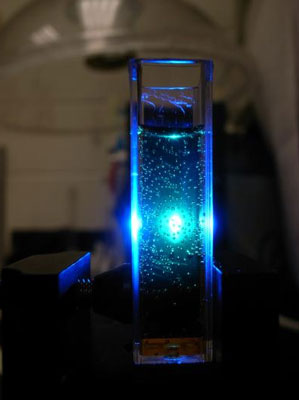| Posted: March 11, 2010 |
Water oxidation advance boosts potential for solar fuel |
|
(Nanowerk News) Emory University chemists have developed the most potent homogeneous catalyst known for water oxidation, considered a crucial component for generating clean hydrogen fuel using only water and sunlight. The breakthrough, published March 11 in the journal Science, was made in collaboration with the Paris Institute of Molecular Chemistry. The fastest, carbon-free molecular water oxidation catalyst (WOC) to date "has really upped the standard from the other known homogeneous WOCs," said Emory inorganic chemist Craig Hill, whose lab led the effort. "It's like a home run compared to a base hit."
|
|
In order to be viable, a WOC needs selectivity, stability and speed. Homogeneity is also a desired trait, since it boosts efficiency and makes the WOC easer to study and optimize. The new WOC has all of these qualities, and it is based on the cheap and abundant element cobalt, adding to its potential to help solar energy go mainstream.
|
|
Benjamin Yin, an undergraduate student in Hill's lab, is the lead author on the Science paper. Emory chemists who are co-authors include Hill, Yurii Gueletii, Jamal Musaev, Zhen Luo and Ken Hardcastle. The U.S. Department of Energy funded the work.
|
 |
| Emory University chemists have developed the most potent homogeneous catalyst known for water oxidation, considered a crucial component for generating clean hydrogen fuel using only water and sunlight.
|
|
The WOC research is a component of the Emory Bio-inspired Renewable Energy Center, which aims to mimic natural processes such as photosynthesis to generate clean fuel. The next step involves incorporating the WOC into a solar-driven, water-splitting system.
|
|
The long-term goal is to use sunlight to split water into oxygen and hydrogen. Hydrogen becomes the fuel. Its combustion produces the by-product of water – which flows back into a clean, green, renewable cycle.
|
|
Three main technical challenges are involved: developing a light collector, a catalyst to oxidize water to oxygen and a catalyst to reduce water to hydrogen. All three components need improvement, but a viable WOC may be the most difficult scientific challenge. "We are aiming for a WOC that is free of organic structure, because organic components will combine with oxygen and self-destruct," Hill says. "You'll wind up with a lot of gunk."
|
|
Enzymes are nature's catalysts. The enzyme in the oxygen-evolving center of green plants "is about the least stable catalyst in nature, and one of the shortest lived, because it's doing one of the hardest jobs," Hill says.
|
|
"We've duplicated this complex natural process by taking some of the essential features from photosynthesis and using them in a synthetic, carbon-free, homogeneous system. The result is a water oxidation catalyst that is far more stable than the one found in nature."
|
|
For decades, scientists have been trying to imitate Mother Nature and create a WOC for artificial photosynthesis. Nearly all of the more than 40 homogeneous WOCs developed by labs have had significant limitations, such as containing organic components that burn up quickly during the water oxidation process.
|
|
Two years ago, Hill's lab and collaborators developed the first prototype of a stable, homogenous, carbon-free WOC, which also worked faster than others known at the time. The prototype, however, was based on ruthenium, a relatively rare and expensive element.
|
|
Building on that work, the researchers began experimenting with the cheaper and more abundant element cobalt. The cobalt-based WOC has proved even faster than the ruthenium version for light-driven water oxidation.
|

